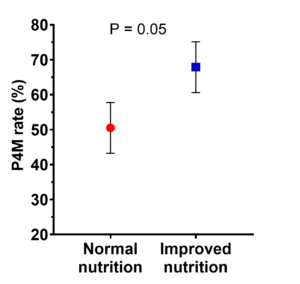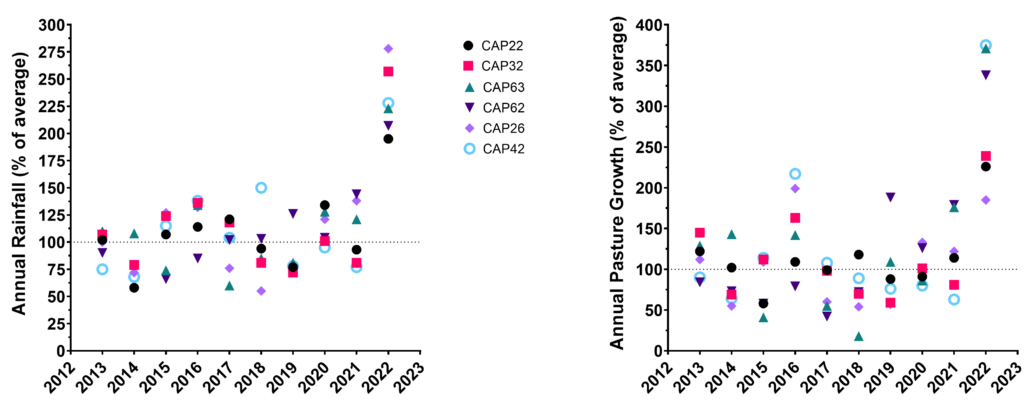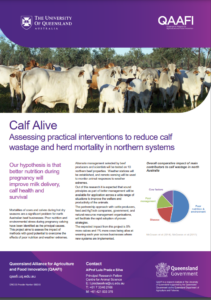Calf Alive – Assessing practical interventions to reduce calf wastage and herd mortality in northern systems
Calf loss and heifer mortality have been major topics of conversation in the north for years, and frankly, people can talk about it until the cows come home. In terms of the issues relating to or causing these losses, we know that poor nutrition and environmental stress play a major role. It begs the question: what are some practical interventions to minimise such losses related to nutrition and environment?
Over the past two seasons, the University of Queensland’s Calf Alive team have been doing just that. The team have been working with 10 beef producing operations across Queensland and the Northern Territory to gain insights into practical, achievable and result driven solutions.
The Calf Alive project aims to:
- Test the cost-effectiveness of nutritional strategies to increase calf survival, reduce herd mortality, and improve calf growth
- Monitor environmental stress and the effects on breeding cows
- Determine if cows that use protein more efficiently during dry seasons can be identified using tail hair tests
- Determine the incidence of mortality in calving 2-year-olds heifers
- Calculate the impact of alternate management to reduce calf mortality on business productivity, profitability and sustainability

Nutrition as the limiting factor
Research indicates that late-pregnant cows in Northern systems often fall short of their nutritional requirements, specifically in protein intake, with breeders receiving less than 500g/day, compared to the required >1kg/day (CSIRO, 2007). Addressing this deficit, the project implemented strategic supplementation, with trial animals assigned to Control (Ctr) or Treatment (Trt) groups. The Trt group receives an additional 300-400g of protein per head per day, introduced six weeks before peak calving. While the 2022-2023 results did not show a link to calf loss, there was a notable increase in pregnancies within four months of calving in the Trt group, especially early in the season. Treatment animals also demonstrated an improved animal live weight production of 16.3kg per cow. Strategic supplementation in controlled studies has shown positive effects on calf health and growth, as well as improvements in protein and immunoglobin composition on colostrum. However, it is emphasized that the impact of supplementation may vary due to seasonal changes, as seen in the unusually high rainfall and pasture growth in 2022. The study underscores the importance of considering pasture protein levels when supplementing and anticipates further evaluation in the drier 2023 season.



Figure 1. Improved nutrition demonstrated increased pregnancies and annual live weight production but did not affect calf loss.
Environment as the limiting factor
The project investigates the environmental factors influencing pasture growth in Northern Australia, particularly focusing on minimum rainfall requirements. Interpolated daily rainfall records from the SILO website (Queensland Government- LongPaddock) were analysed for northern rainfall onset (NRO) and Green Date (GD) metrics. NRO, representing the theoretical minimum rainfall for pasture growth, and GD, the minimum rainfall after September 1st to stimulate growth, exhibit significant variability across years and locations based on data from eight properties (1942-2022). Notably, GD has a larger range and lower probability before mid-December. The research emphasises the importance of understanding NFO and GD timing for effective pasture management decisions, suggesting location-specific definitions for accurate seasonal climate forecasts.

Figure 2. Annual rainfall and pasture growth in 2022 were more than 2-fold higher than the average, leading to high pasture quality (above 10% crude protein) during the prepartum period.
Additionally, Davis Vantage Pro weather stations were installed across all trial sites to assess the relationship between interpolated and measured data. The study shows strong agreement in weekly cumulative rainfall and average daily Total Humidity Index (THI), indicating the potential usefulness of interpolated data in approximating environmental factors affecting livestock production.
Can efficient breeders be flagged through tail hair testing?
Additionally, a pilot study explored the impact of previous lactation and pregnancy on tail hair isotopes. Of the 96 cows in the study, half were in calf, and the other half were empty. The analysis of the tail hair isotopes confirmed lower 15N isotopes in cows with higher reproductive efficiency, indicating reduced nitrogen loss in urine. This suggests the potential use of tail hair isotopes as a tool for selecting more productive cows likely to produce a calf annually.

Figure 3. Illustrates the difference in 15N concentrations in tail hair between cattle that have had a calf every year and those that have not. * Indicates significant difference P<0.05
Mortality rates in heifers
The project further delves into the mortality risk associated with the age at first calf in commercial beef breeding herds, specifically focusing on the heightened risk of early breeding, particularly heifers calving before three years of age. This investigation stems from the potential challenges like foetal-maternal disproportion leading to dystocia and increased nutritional requirements during pregnancy and lactation. The pilot study, conducted on a single commercial operation, revealed a significant 2.6% occurrence of missingness in first-calf heifers, with predications of higher missingness in yearling heifers. Statistical analysis established a significant association between pregnancy, age at first calving, and their interaction.
The impact of alternate management on your breeder business bottom line
The current rate of calf wastage is not sustainable and threatens the core of the beef industry in our region. While the project is still investigating the business economics surrounding calf loss and the impacts of real-life interventions to minimise calf and heifer wastage, the project aims to help the industry produce 11,700 tonnes of additional annual liveweight sales by 2031.
The partnership approach with cattle producers, feed and AgTech companies, governments, Meat and Livestock Australia, and natural resource management organisations, will facilitate the rapid adoption of proven strategies. The expected impact from this project is 5% more calves and 1% more cows being alive at weaning each year across businesses where new systems are implemented.
Contact
A/Prof Luis Prada e Silva
Principal Research Fellow
Centre for Animal Science
E: l.pradaesilva@uq.edu.au
T: +61 7 3346 2166
M: +61 421 833 376
Abstracts submitted to NBRUC 2023
- The impact of prepartum supplementation on the liveweight of cows
- The impact of previous lactation and pregnancy status in tail hair isotopes
- Calf Alive: Quantifying the mortality-risk associated with age at first calf in commercial beef breeding herds
- Calf Alive: Agreement between interpolated and measured weekly rainfall and temperature humidity index (THI)
- Calf Alive: Attendance of study animals at walkoverweigh and autodrafting
- Variability of minimum rainfall requirements for pasture response in northern Australia
Additional Information
- Strategic Supplementation Case Study – Manbulloo Station, NT
- Calf Alive: better diet boosting health outcomes in northern beef cattle herds
November 2021
March 2018:
- Calf alive symposium presentations
- Calf alive symposium panel Day 1
- Calf alive symposium panel Day 2
- Producers gather for Calf Alive Symposium
This project is funded by Meat and Livestock Australia and supported by the University of Queensland, Queensland Alliance of Agriculture and Food Innovation, Queensland Department of Agriculture and Fisheries, Northern Breeding Business, Northern Territory Government Department of Industry, Tourism and Trade and Feedworks.

